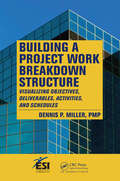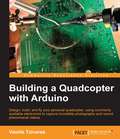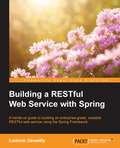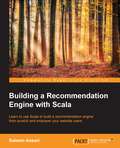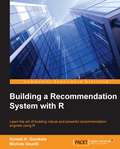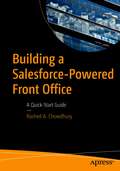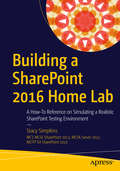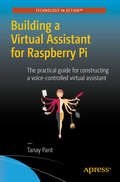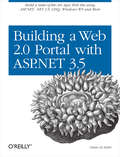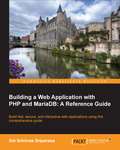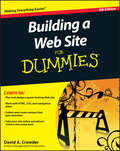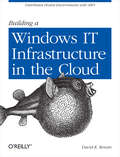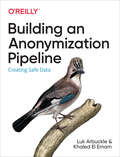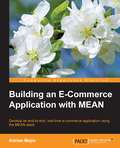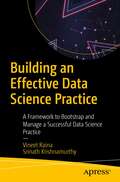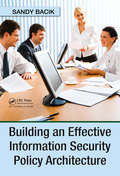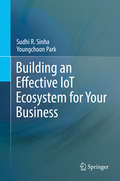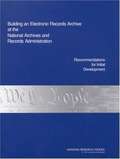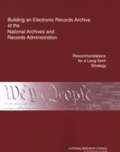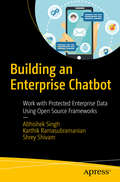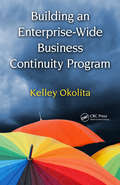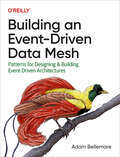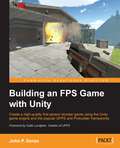- Table View
- List View
Building a Programmable Logic Controller with a PIC16F648A Microcontroller
by Murat UzamProgrammable logic controllers (PLCs) are extensively used in industry to perform automation tasks, with manufacturers offering a variety of PLCs that differ in functions, program memories, and the number of inputs/outputs (I/O). Not surprisingly, the design and implementation of these PLCs have long been a secret of manufacturers. Unveiling the mysteries of PLC technology, Building a Programmable Logic Controller with PIC16F648A Microcontroller explains how to design and use a PIC16F648A-microcontroller-based PLC. The author first described a microcontroller-based implementation of a PLC in a series of articles published in Electronics World magazine between 2008 and 2010. This book is based on an improved version of the project, including:Updates to the hardware configuration, with a smaller CPU board and two I/O extension boards that now support 16 inputs and 16 outputs instead of 8An increased clock frequency of 20 MHzImprovements to several macrosFlowcharts to help you understand the macros (functions)In this book, the author provides detailed explanations of hardware and software structures. He also describes PIC Assembly macros for all basic PLC functions, which are illustrated with numerous examples and flowcharts. An accompanying CD contains source files (.ASM) and object files (.HEX) for all of the examples in the book. It also supplies printed circuit board (PCB) (Gerber and .pdf) files so that you can have the CPU board and I/O extension boards produced by a PCB manufacturer or produce your own boards.Making PLCs more easily accessible, this unique book is written for advanced students, practicing engineers, and hobbyists who want to learn how to build their own microcontroller-based PLC. It assumes some previous knowledge of digital logic design, microcontrollers, and PLCs, as well as familiarity with the PIC16F series of microcontrollers and w
Building a Project Work Breakdown Structure: Visualizing Objectives, Deliverables, Activities, and Schedules (ESI International Project Management Series)
by Dennis P. MillerMost people do not truly understand a concept until they can visualize it. This applies to all fields, including Project Management. The best way to effectively manage projects is to help your team visualize the end result as well as the steps needed to achieve that result.Help Your Team Visualize the Right Path to SuccessBuilding a Project Work Br
Building a Quadcopter with Arduino
by Vasilis TzivarasDesign, build, and fly your personal quadcopter using market electronics to capture incredible photographs and record phenomenal videosAbout This BookGrasp the knowledge required to assemble your drone with light and cost effective materialsEnlighten your understanding about the flight by performing step-by-step pre-flight adjustments and acquiring the instructions for a safe flightGet the best tips to deal with performance issues related to your quadcopterWho This Book Is ForThis book is intended for hobbyists who are looking forward to fulfill their dream of flying a quadcopter clearly made by them. Some basic experience in electronic circuits and aerial vehicles will make it easier for you, however it isn't mandatory.What You Will LearnReview and choose the most suitable material for the buildSet up and calibrate all of your electronic partsControl and fly your quadcopter taking into account the weather conditionsMaintain your vehicle as much as possible and repair it whenever requiredEngineer the structure of your vehicleDevelop a flight controller with its basic principlesEliminate possible malfunctions in the futureRepair your drone if it crashes or faces any damageIn DetailQuadcopters, also known as quadrotors, are gaining more and more popularity in today's world. With the help of these devices, anyone can have an "eye in the sky" and can monitor any place at any time. You can capture photographs and once a while and perform automated tasks. In this book, you will be informed about all the basic modules and electronics needed to fly a simple quadcopter. You'll delve deep to create a fully-functional quadcopter quickly with the help of Arduino boards. Through this book, you'll develop the skills needed to build a DIY drone that can capture pictures and record videos.Style and approachThis is an easy-to-follow guide with pictorial depictions and technical descriptions to assemble your vehicle.
Building a RESTful Web Service with Spring
by Ludovic DewaillyA hands-on guide to building an enterprise-grade, scalable RESTful web service using the Spring Framework About This Book * Follow best practices and explore techniques such as clustering and caching to achieve a scalable web service * Leverage the Spring Framework to quickly implement RESTful endpoints * Learn to implement a client library for a RESTful web service using the Spring Framework Who This Book Is For This book is intended for those who want to learn to build RESTful web services with the Spring Framework. To make best use of the code samples included in the book, you should have a basic knowledge of the Java language. Previous experience with the Spring Framework would also help you get up and running quickly. What You Will Learn * Deep dive into the principles behind REST * Expose CRUD operations through RESTful endpoints with the Spring Framework * Devise response formats and error handling strategies, offering a consistent and flexible structure to simplify integration for service consumers * Follow the best approaches for dealing with a service's evolution while maintaining backward compatibility * Understand techniques to secure web services * Comply with the best ways to test RESTful web services, including tips for load testing * Optimise and scale web services using techniques such as caching and clustering In Detail REST is an architectural style that tackles the challenges of building scalable web services. In today's connected world, APIs have taken a central role on the web. APIs provide the fabric through which systems interact, and REST has become synonymous with APIs. The depth, breadth, and ease of use of Spring makes it one of the most attractive frameworks in the Java ecosystem. Marrying the two technologies is therefore a very natural choice. This book takes you through the design of RESTful web services and leverages the Spring Framework to implement these services. Starting from the basics of the philosophy behind REST, you'll go through the steps of designing and implementing an enterprise-grade RESTful web service. Taking a practical approach, each chapter provides code samples that you can apply to your own circumstances. This book goes beyond the use of Spring and explores approaches to tackle resilience, security, and scalability concerns. You'll learn techniques to deal with security in Spring and discover how to implement unit and integration test strategies. Finally, the book ends by walking you through building a Java client for your RESTful web service, along with some scaling techniques for it. Style and approach This book is a step-by-step, hands-on guide to designing and building RESTful web services. The book follows the natural cycle of developing these services and includes multiple code samples to help you.
Building a Recommendation Engine with Scala
by Saleem AnsariLearn to use Scala to build a recommendation engine from scratch and empower your website usersAbout This BookLearn the basics of a recommendation engine and its application in e-commerceDiscover the tools and machine learning methods required to build a recommendation engineExplore different kinds of recommendation engines using Scala libraries such as MLib and SparkWho This Book Is ForThis book is written for those who want to learn the different tools in the Scala ecosystem to build a recommendation engine. No prior knowledge of Scala or recommendation engines is assumed.What You Will LearnDiscover the tools in the Scala ecosystemUnderstand the challenges faced in e-commerce systems and learn how you can solve those challenges with a recommendation engineFamiliarise yourself with machine learning algorithms provided by the Apache Spark frameworkBuild different versions of recommendation engines from practical code examplesEnhance the user experience by learning from user feedbackDive into the various techniques of recommender systems such as collaborative, content-based, and cross-recommendationsIn DetailWith an increase of data in online e-commerce systems, the challenges in assisting users with narrowing down their search have grown dramatically. The various tools available in the Scala ecosystem enable developers to build a processing pipeline to meet those challenges and create a recommendation system to accelerate business growth and leverage brand advocacy for your clients.This book provides you with the Scala knowledge you need to build a recommendation engine.You'll be introduced to Scala and other related tools to set the stage for the project and familiarise yourself with the different stages in the data processing pipeline, including at which stages you can leverage the power of Scala and related tools. You'll also discover different machine learning algorithms using MLLib.As the book progresses, you will gain detailed knowledge of what constitutes a collaborative filtering based recommendation and explore different methods to improve users' recommendation.Style and approachA step-by-step guide full of real-world, hands-on examples of Scala recommendation engines. Each example is placed in context with explanation and visuals.
Building a Recommendation System with R
by Michele Usuelli Suresh K. GorakalaLearn the art of building robust and powerful recommendation engines using R About This Book * Learn to exploit various data mining techniques * Understand some of the most popular recommendation techniques * This is a step-by-step guide full of real-world examples to help you build and optimize recommendation engines Who This Book Is For If you are a competent developer with some knowledge of machine learning and R, and want to further enhance your skills to build recommendation systems, then this book is for you. What You Will Learn * Get to grips with the most important branches of recommendation * Understand various data processing and data mining techniques * Evaluate and optimize the recommendation algorithms * Prepare and structure the data before building models * Discover different recommender systems along with their implementation in R * Explore various evaluation techniques used in recommender systems * Get to know about recommenderlab, an R package, and understand how to optimize it to build efficient recommendation systems In Detail A recommendation system performs extensive data analysis in order to generate suggestions to its users about what might interest them. R has recently become one of the most popular programming languages for the data analysis. Its structure allows you to interactively explore the data and its modules contain the most cutting-edge techniques thanks to its wide international community. This distinctive feature of the R language makes it a preferred choice for developers who are looking to build recommendation systems. The book will help you understand how to build recommender systems using R. It starts off by explaining the basics of data mining and machine learning. Next, you will be familiarized with how to build and optimize recommender models using R. Following that, you will be given an overview of the most popular recommendation techniques. Finally, you will learn to implement all the concepts you have learned throughout the book to build a recommender system. Style and approach This is a step-by-step guide that will take you through a series of core tasks. Every task is explained in detail with the help of practical examples.
Building a Salesforce-Powered Front Office: A Quick-Start Guide
by Rashed A. ChowdhuryHarness the power of Salesforce to manage and grow your business. This book shows you how to use the Salesforce CRM tool to consolidate consumer data into a single place to gain better insight into your business and more easily manage data.Data (such as email, spreadsheets, databases) is generated through the front office or face of your business, where your company interacts with customers and revenue is generated. In a hotel, for instance, the front office is the lobby where guests are greeted, their problems are handled, and room payments are made. Another example is a coffee shop, where the front office is an employee taking a customer's order or serving a drink.Salespeople connect to customers by selling your company’s goods or services. Marketing team members connect with them through advertising and promotional activities. Service and support staff assist customers with problems and provide help with products.This book introduces the many ways Salesforce-based innovations are transforming the technology landscape and the strategies that may be used for designing and launching a digital front office. The book examines how organizations can launch and grow digital solutions and strategies for the governance of the platform and provides an overview of digital transformation across industries. What You Will Learn Understand basic Salesforce concepts, including the digital front office process tower, lead to cash journey, core CRM functions, best practices, and moreReview data management concepts, integrated sales, customer service, marketing operations, and proposal and business development needs in a systematic wayUse frameworks to build a business architecture and multi-year technology roadmapGet familiar with Salesforce business processes and concepts such as account, contact, lead, and opportunity management; marketing campaigns; master data management (MDM); and lead scoring, grading, and activity management across the front officeDefine and develop digital marketing challenges and strategy (people, process, brand, messaging, and ROI), measure campaign data, and create an end-to-end campaign in Salesforce Who This Book Is ForBusiness executives, C-suites, IT management, and Salesforce managers and professionals working in IT, business development, sales operations, program management, marketing operations, and proposal development
Building a SharePoint 2016 Home Lab: A How-To Reference on Simulating a Realistic SharePoint Testing Environment
by Stacy SimpkinsThis book is a step-by-step guide to building your own SharePoint farm in a home lab setting. Learn how to build a windows domain and then join servers into the domain in order to create your own testing and learning environment. After you get the domain stood up, where you go from there is up to you. This book will help you learn how to spin up SharePoint in a least privileged fashion. This isn t strictly a SharePoint book, though. For example, if you re not a SharePoint professional and are just looking to create a working windows domain for other purposes; the home-lab domain that you ll create will work great for Exam preparation for non-SharePoint purposes. You could even use it for learning how to install Exchange Server. After all, it s your Home Lab domain. In this book you will build your home-lab domain and you ll have a great place for learning how to administer SharePoint and develop SharePoint Apps. Here are just some of the tasks you ll complete in easy to follow exercises: Create a windows domain and a certificate authority, so that you can run SharePoint on SSLJoin servers to the domain and configure other technology on the member servers as neededInstall SQL Server, and correctly partition the server in accordance with best practicesInstall and configure a SharePoint farmSpin up Host Named Site Collections (HNSC s)Install and configure Visual StudioWho This Book Is For: This book is suitable for both developers and administrators. No technical knowledge is assumed beyond a general familiarity with computers and computing terminology. The resulting domain will be suitable for both IT and developer testing needs. "
Building a Virtual Assistant for Raspberry Pi: The practical guide for constructing a voice-controlled virtual assistant
by Tanay PantBuild a voice-controlled virtual assistant using speech-to-text engines, text-to-speech engines, and conversation modules. This book shows you how to program the virtual assistant to gather data from the internet (weather data, data from Wikipedia, data mining); play music; and take notes. Each chapter covers building a mini project/module to make the virtual assistant better. You'll develop the software on Linux or OS X before transferring it to your Raspberry Pi, ready for deploying in your own home-automation or Internet of Things applications. Building a Virtual Assistant for Raspberry Pi walks you through various STTs and TTSs and the implementation of these components with the help of Python. After that you will start implementing logic for handling user queries and commands, so that the user can have conversations with Melissa. You will then work to improve logic handling to detect what the user wants Melissa to do. You will also work on building some useful applications/modules for Melissa, which will allow you to gain interesting information from Melissa such as the time, weather information, and data from Wikipedia. You will develop a music playing application as well as a note taking application for Melissa, laying the foundations for how Melissa can be further extended. Finally, you will learn how to deploy this software to your Raspberry Pi and how you can further scale Melissa to make her more intelligent, interactive and how you can use her in other projects such as home automation as well. What You'll Learn Design the workflow and discover the concepts of building a voice controlled assistantDevelop modules for having conversations with the assistantEnable the assistant to retrieve information from the internetBuild utilities like a music player and a note taking application for the virtual assistantIntegrate this software with a Raspberry Pi Who This Book Is For This book is for anyone who has built a home automation project with Raspberry Pi and now want to enhance it by making it voice-controlled. The book would also interest students from computer science or related disciplines.
Building a Web 2.0 Portal with ASP.NET 3.5: Learn How to Build a State-of-the-Art Ajax Start Page Using ASP.NET, .NET 3.5, LINQ, Windows WF, and More
by Omar Al ZabirIf you think you're well versed in ASP.NET, think again. This exceptional guide gives you a master class in site building with ASP.NET 3.5 and other cutting-edge Microsoft technologies. You learn how to develop rock-solid web portal applications that can withstand millions of hits every day while surviving scalability and security pressures -- not just for mass-consumer homepages, but also for dashboards that deliver powerful content aggregation for enterprises.Written by Omar AL Zabir, co-founder and CTO of Pageflakes, Building a Web 2.0 Portal with ASP.NET 3.5 demonstrates how to develop portals similar to My Yahoo!, iGoogle, and Pageflakes using ASP.NET 3.5, ASP.NET AJAX, Windows Workflow Foundation, LINQ and .NET 3.5. Through the course of the book, AL Zabir builds an open source Ajax-enabled portal prototype (available online at www.dropthings.com), and walks you though the design and architectural challenges, advanced Ajax concepts, performance optimization techniques, and server-side scalability problems involved.You learn how to:Implement a highly decoupled architecture following the popular n-tier, widget-based application modelProvide drag-and-drop functionality, and use ASP.NET 3.5 to build the server-side part of the web layerUse LINQ to build the data access layer, and Windows Workflow Foundation to build the business layer as a collection of workflowsBuild client-side widgets using JavaScript for faster performance and better cachingGet maximum performance out of the ASP.NET AJAX Framework for faster, more dynamic, and scalable sitesBuild a custom web service call handler to overcome shortcomings in ASP.NET AJAX 1.0 for asynchronous, transactional, cache-friendly web servicesOvercome JavaScript performance problems, and help the user interface load faster and be more responsiveSolve scalability and security problems as your site grows from hundreds to millions of usersDeploy and run a high-volume production site while solving software, hardware, hosting, and Internet infrastructure problemsBuilding a Web 2.0 Portal with ASP.NET 3.5 also presents real-world ASP.NET challenges that the author has solved in building educational and enterprise portals, plus thirteen production disasters common to web applications serving millions of users. If you're ready to build state-of-the art, high-volume web applications, this book has exactly what you need.
Building a Web Application with PHP and MariaDB: A Reference Guide
by Sai Srinivas SriparasaThis is a step-by-step, tutorial guide designed to help readers transition from beginners to more experienced developers using clear explanations. The variety of examples will help readers build, secure, and host real-time web applications. If you are a developer who wants to use PHP and MariaDB to build web applications, this book is ideal for you. Beginners can use this book to start with the basics and learn how to build and host web applications. Seasoned PHP Developers can use this book to get familiar with the new features of PHP 5.4 and 5.5, unit testing, caching, security, and performance optimization.
Building a Web Site For Dummies
by David A. CrowderThe bestselling guide to building a knockout Web site, newly updatedAn effective Web site is the key to success for every venture from class reunions to major corporations. And since Web technology changes rapidly, Building a Web Site For Dummies, 4th Edition is fully updated for the cutting-edge tools and trends.If you need to build and maintain a Web site, even if your experience is severely limited, this book makes it easy and fun. You'll learn to plan, design, create, launch, and maintain your site using the most up-to-date tools.A quality Web presence is essential in today's marketplace, and many individuals charged with creating one are unaware of the challengesThis guide gives novice Web designers the tools and know-how to plan, design, and build effective Web sitesProvides a nuts-and-bolts guide to site-building, including coverage of HTML, WYSIWYG construction software, CSS, and navigation plansShows how to spruce up your site with topnotch graphics, video, and great contentGuides you through getting your site online, promoting it, and even making money from itBuilding a Web Site For Dummies, 4th Edition is the tool every first-time Web designer needs to build a professional-looking site.
Building a Windows IT Infrastructure in the Cloud: Distributed Hosted Environments with AWS
by David K. RensinRun your entire corporate IT infrastructure in a cloud environment that you control completely—and do it inexpensively and securely with help from this hands-on book. All you need to get started is basic IT experience.You’ll learn how to use Amazon Web Services (AWS) to build a private Windows domain, complete with Active Directory, enterprise email, instant messaging, IP telephony, automated management, and other services. By the end of the book, you’ll have a fully functioning IT infrastructure you can operate for less than $300 per month.Learn about Virtual Private Cloud (VPC) and other AWS tools you’ll useCreate a Windows domain and set up a DNS management systemInstall Active Directory and a Windows Primary Domain ControllerUse Microsoft Exchange to set up an enterprise email serviceImport existing Windows Server-based virtual machines into your VPCSet up an enterprise-class chat/IM service, using the XMPP protocolInstall and configure a VoIP PBX telephony system with Asterisk and FreePBXKeep your network running smoothly with automated backup and restore, intrusion detection, and fault alerting
Building an Anonymization Pipeline: Creating Safe Data
by Luk Arbuckle Khaled El EmamHow can you use data in a way that protects individual privacy but still provides useful and meaningful analytics? With this practical book, data architects and engineers will learn how to establish and integrate secure, repeatable anonymization processes into their data flows and analytics in a sustainable manner.Luk Arbuckle and Khaled El Emam from Privacy Analytics explore end-to-end solutions for anonymizing device and IoT data, based on collection models and use cases that address real business needs. These examples come from some of the most demanding data environments, such as healthcare, using approaches that have withstood the test of time.Create anonymization solutions diverse enough to cover a spectrum of use casesMatch your solutions to the data you use, the people you share it with, and your analysis goalsBuild anonymization pipelines around various data collection models to cover different business needsGenerate an anonymized version of original data or use an analytics platform to generate anonymized outputsExamine the ethical issues around the use of anonymized data
Building an E-Commerce Application with MEAN
by Adrian MejiaDevelop an end-to-end, real-time e-commerce application using the MEAN stack About This Book * Build all the main components of an e-commerce website and extend its high-quality features as per your needs * Get to grips with the full-stack JavaScript to build attractive e-commerce sites and start making money * A step-by-step guide to developing the MEAN stack components from scratch to achieve maximum flexibility when building an e-commerce application Who This Book Is For This book is for a web or full stack JavaScript developer who wants to get a head start on developing an e-commerce application with MEAN. A basic knowledge of the MEAN stack is highly recommended. What You Will Learn * Employ AngularJS to build responsive UI components * Implement multiple authentication strategies such as OAuth, JsonWebToken, and Sessions * Enhance website usability with social logins such as Facebook, Twitter, and Google * Create integrations with payment platforms such as PayPal * Apply full-text search functionality in MongoDB * Build a flexible categorization system to organize your products * Secure your app by creating SSL certificates and run payment platforms in a live environment In Detail MEAN stands for MongoDB, Express, AngularJS, and Node.js. It is a combination of a NoSQL database, MongoDB, with a couple of JavaScript web application frameworks, namely Express.js and Angular.js. These run on Node.js. There is always an ever-growing list of requirements while designing an e-commerce application, which needs to be flexible enough for easy adaptation. The MEAN stack allows you to meet those requirements on time and build responsive applications using JavaScript. This book will show you how to create your own e-commerce application using the MEAN stack. It will take you step by step through the parallel process of learning and building. It will also teach you to develop a production-ready, high-quality e-commerce site from scratch and will provide the knowledge you need to extend your own features to the e-commerce site. This book starts with a short introduction to the MEAN stack, followed by a step-by-step guide on how to build a store with AngularJS, set up a database with MongoDB, create a REST API, and wire AngularJS. It also shows you how to manage user authentication and authorization, check multiple payment platforms, add products' search and navigation, deploy a production-ready e-commerce site, and finally add your own high-quality feature to the site. By the end of the book, you will be able to build and use your own e-commerce app in the real world and will also be able to add your own new features to it. Style and approach This book is a step-by-step guide on how to build a real-time e-commerce app with MEAN. Each transition is well explained, and each chapter begins with the required background knowledge.
Building an Effective Data Science Practice: A Framework to Bootstrap and Manage a Successful Data Science Practice
by Vineet Raina Srinath KrishnamurthyGain a deep understanding of data science and the thought process needed to solve problems in that field using the required techniques, technologies and skills that go into forming an interdisciplinary team. This book will enable you to set up an effective team of engineers, data scientists, analysts, and other stakeholders that can collaborate effectively on crucial aspects such as problem formulation, execution of experiments, and model performance evaluation.You’ll start by delving into the fundamentals of data science – classes of data science problems, data science techniques and their applications – and gradually build up to building a professional reference operating model for a data science function in an organization. This operating model covers the roles and skills required in a team, the techniques and technologies they use, and the best practices typically followed in executing data science projects.Building an Effective Data Science Practice provides a common base of reference knowledge and solutions, and addresses the kinds of challenges that arise to ensure your data science team is both productive and aligned with the business goals from the very start. Reinforced with real examples, this book allows you to confidently determine the strategic answers to effectively align your business goals with the operations of the data science practice. What You’ll Learn Transform business objectives into concrete problems that can be solved using data scienceEvaluate how problems and the specifics of a business drive the techniques and model evaluation guidelines used in a projectBuild and operate an effective interdisciplinary data science team within an organizationEvaluating the progress of the team towards the business RoIUnderstand the important regulatory aspects that are applicable to a data science practice Who This Book Is For Technology leaders, data scientists, and project managers
Building an Effective Information Security Policy Architecture
by Sandy BacikInformation security teams are charged with developing and maintaining a set of documents that will protect the assets of an enterprise from constant threats and risks. In order for these safeguards and controls to be effective, they must suit the particular business needs of the enterprise.A guide for security professionals, Building an Eff
Building an Effective IoT Ecosystem for Your Business
by Sudhi R. Sinha Youngchoon ParkThis descriptive, practical guide explains how to build a commercially impactful, operationally effective and technically robust IoT ecosystem that takes advantage of the IoT revolution and drives business growth in the consumer IoT as well as industrial internet spaces. With this book, executives, business managers, developers and decision-makers are given the tools to make more informed decisions about IoT solution development, partner eco-system design, and the monetization of products and services. Security and privacy issues are also addressed. Readers will explore the design guidelines and technology choices required to build commercially viable IoT solutions, but also uncover the various monetization and business modeling for connected products.
Building an Electronic Records Archive at the National Archives and Records Administration: Recommendations for Initial Development
by Committee on Digital Archiving the National Archives Records AdministrationA report on Building an Electronic Records Archive at the National Archives and Records Administration.
Building an Electronic Records Archive at the National Archives and Records Administration: Recommendations for a Long-Term Strategy
by National Research Council of the National AcademiesThe federal government generates and increasingly saves a large and growing fraction of its records in electronic form. In 1998, the National Archives and Record Administration (NARA) launched its Electronic Archives (ERA) program to create a system to preserve and provide access to federal electronic records. To assist in this project, NARA asked the NRC to conduct a two-phase study to provide advice as it develops the ERA program. The first two reports (phase one) provided recommendations on design, engineering, and related issues facing the program. This report (phase two) focuses on longer term, more strategic issues including technology trends that will shape the ERA system, archival processes of the ERA, and future evolution of the system. It also provides an assessment of technical and design issues associated with record integrity and authenticity.
Building an Enterprise Chatbot: Work with Protected Enterprise Data Using Open Source Frameworks
by Karthik Ramasubramanian Abhishek Singh Shrey ShivamExplore the adoption of chatbots in business by focusing on the design, deployment, and continuous improvement of chatbots in a business, with a single use-case from the banking and insurance sector. This book starts by identifying the business processes in the banking and insurance industry. This involves data collection from sources such as conversations from customer service centers, online chats, emails, and other NLP sources. You’ll then design the solution architecture of the chatbot. Once the architecture is framed, the author goes on to explain natural language understanding (NLU), natural language processing (NLP), and natural language generation (NLG) with examples. In the next sections, you'll design and implement the backend framework of a typical chatbot from scratch. You will also explore some popular open-source chatbot frameworks such as Dialogflow and LUIS. The authors then explain how you can integrate various third-party services and enterprise databases with the custom chatbot framework. In the final section, you'll discuss how to deploy the custom chatbot framework on the AWS cloud.By the end of Building an Enterprise Chatbot, you will be able to design and develop an enterprise-ready conversational chatbot using an open source development platform to serve the end user.What You Will LearnIdentify business processes where chatbots could be usedFocus on building a chatbot for one industry and one use-case rather than building a ubiquitous and generic chatbot Design the solution architecture for a chatbotIntegrate chatbots with internal data sources using APIsDiscover the differences between natural language understanding (NLU), natural language processing (NLP), and natural language generation (NLG) Work with deployment and continuous improvement through representational learningWho This Book Is ForData scientists and enterprise architects who are currently looking to deploy chatbot solutions to their business.
Building an Enterprise-Wide Business Continuity Program
by Kelley OkolitaIf you had to evacuate from your building right now and were told you couldn't get back in for two weeks, would you know what to do to ensure your business continues to operate? Would your staff? Would every person who works for your organization? Increasing threats to business operations, both natural and man-made, mean a disaster could occur at any time. It is essential that corporations and institutions develop plans to ensure the preservation of business operations and the technology that supports them should risks become reality. Building an Enterprise-Wide Business Continuity Program goes beyond theory to provide planners with actual tools needed to build a continuity program in any enterprise. Drawing on over two decades of experience creating continuity plans and exercising them in real recoveries, including 9/11 and Hurricane Katrina, Master Business Continuity Planner, Kelley Okolita, provides guidance on each step of the process. She details how to validate the plan and supplies time-tested tips for keeping the plan action-ready over the course of time. Disasters can happen anywhere, anytime, and for any number of reasons. However, by proactively planning for such events, smart leaders can prepare their organizations to minimize tragic consequences and readily restore order with confidence in the face of such adversity.
Building an Event-Driven Data Mesh: Patterns for Designing & Building Event-Driven Architectures
by Adam BellemareThe exponential growth of data combined with the need to derive real-time business value is a critical issue today. An event-driven data mesh can power real-time operational and analytical workloads, all from a single set of data product streams. With practical real-world examples, this book shows you how to successfully design and build an event-driven data mesh.Building an Event-Driven Data Mesh provides:Practical tips for iteratively building your own event-driven data mesh, including hurdles you'll experience, possible solutions, and how to obtain real value as soon as possibleSolutions to pitfalls you may encounter when moving your organization from monoliths to event-driven architecturesA clear understanding of how events relate to systems and other events in the same stream and across streamsA realistic look at event modeling options, such as fact, delta, and command type events, including how these choices will impact your data productsBest practices for handling events at scale, privacy, and regulatory complianceAdvice on asynchronous communication and handling eventual consistency
Building an FPS Game with Unity
by John P. DoranCreate a high-quality first person shooter game using the Unity game engine and the popular UFPS and Probuilder frameworksAbout This BookLearn how to use Unity in conjunction with UFPS and ProBuilder to create a high-quality game quicklyCreate both interior and exterior environmentsA step-by step guide to building a project with clear examples and instructions to create a number of interesting scenariosWho This Book Is ForThis book is for those who want to create an FPS game in Unity and gain knowledge on how to customize it to be their very own. If you are familiar with the basics of Unity, you will have an easier time, but it should make it possible for someone with no prior experience to learn Unity at an accelerated pace.What You Will LearnUse UFPS to build custom weapons with custom meshes and behaviorsExplore level design as you prototype levels, making use of Prototype to build levels out quicklyBuild environments that are realistic as possible while keeping peak performance and repetitiveness downReview tips and tricks on how to create environments using both terrain for outdoor areas and a modular workflow for interiorsDevelop a number of different encounters that your players can fight against, from a simple turret enemy to complex AI characters from Shooter AIDiscover how to create unique objects such as exploding barrels and objects you can interact withCreate a custom GUI to help your game stand out from the crowdPackage your game for release, create an installer, and get your game out into the worldIn DetailUnity, available in free and pro versions, is one of the most popular third-party game engines available. It is a cross-platform game engine, making it easy to write your game once and then port it to PC, consoles, and even the web, making it a great choice for both indie and AAA developers.Building an FPS Game in Unity takes readers on an exploration of how to use Unity to create a 3D first person shooter (FPS) title, leveraging the powerful UFPS framework by VisionPunk and Prototype/ProBuilder 2.0 by ProCore3D.After some setting up, you will start by learning how to create custom weapons, prototype levels, create exterior and interior environments, and breathe life into our levels. We will then add polish to the levels. Finally, we will create a custom GUI and menus for our title to create a complete package.Style and approachAn easy-to-follow guide with each project containing step-by-step explanations, diagrams, screenshots, and downloadable material. Concepts in Unity and C# are explained as they are used and for the more inquisitive, there are more details on the concepts used with additional external resources to learn from.
Building an Information Security Awareness Program
by Mark B. DesmanIn his latest book, a pre-eminent information security pundit confessed that he was wrong about the solutions to the problem of information security. It's not technology that's the solution, but the human factor-people. But even infosec policies and procedures are insufficient if employees don't know about them, or why they're important, or what ca

